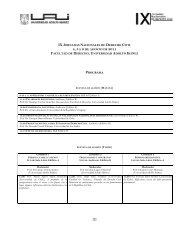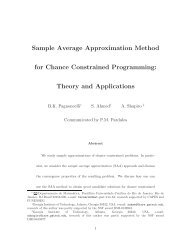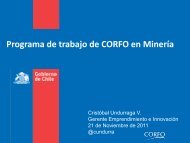On the exact separation of mixed integer knapsack cuts - Marcos ...
On the exact separation of mixed integer knapsack cuts - Marcos ...
On the exact separation of mixed integer knapsack cuts - Marcos ...
You also want an ePaper? Increase the reach of your titles
YUMPU automatically turns print PDFs into web optimized ePapers that Google loves.
36 R. Fukasawa, M. GoycooleaIn an attempt to answer this question we fine-tuned <strong>the</strong> settings <strong>of</strong> <strong>the</strong> MIR heuristicfor <strong>the</strong> problems p0033, p0548 and qnet1. In <strong>the</strong>se, we managed to improve <strong>the</strong> value<strong>of</strong> MIR-PERF from 87.31 to 100%, from 62.66 to 63.66% and from 56.68 to 77.27%respectively. This indicates that <strong>the</strong> true value <strong>of</strong> MIR-REL may be much closer to100% than suggested by <strong>the</strong> table.4.1.2 Knapsack <strong>cuts</strong> derived from tableau rowsIn order to obtain T for a given problem instance, we first solve <strong>the</strong> linear programmingrelaxation <strong>of</strong> <strong>the</strong> corresponding problem and let T be <strong>the</strong> implied <strong>knapsack</strong> setsinduced by <strong>the</strong> optimal tableau rows in <strong>the</strong> augmented variable space consisting <strong>of</strong>both structural and slack variables. When attempting to generate a cut from a tableaurow our algorithms all worked in this augmented space. Whenever a cut was generatedfrom a tableau row, we would first substitute out slack variables before adding it backto <strong>the</strong> LP. Slack variables were always assumed to be non-negative and continuous.We now discuss <strong>the</strong> computational results obtained for K = T . Of <strong>the</strong> 92 instancesin MIPLIB 3.0 and MIPLIB2003, we were able to compute <strong>the</strong> values z T Mfor 48 <strong>of</strong><strong>the</strong>m. Of <strong>the</strong>se 48 problems, 4 <strong>of</strong> <strong>the</strong>m were such that ORIG-GAP was equal to 0.0(disctom, dsbmip, enigma, and noswot), and 2 <strong>of</strong> <strong>the</strong>m were such that KNAP-PERFand MIR-PERF were both equal to 0.0 (stein27 and stein45). In Table 3 we present<strong>the</strong> results for <strong>the</strong> remaining 42 problems.First, it is important to remark that separating <strong>knapsack</strong> <strong>cuts</strong> from tableau rowswas much more difficult than from original formulation rows. This is because tableaurows are typically more dense, with more ill-conditioned coefficients, and with morecontinuous variables. This can be seen in that only 48 <strong>of</strong> 92 instances were solved, asopposed to <strong>the</strong> 79 which were solved for formulation rows.Second, it is interesting to note that <strong>the</strong> value KNAP-PERF is very erratic, uniformlyranging in values from 100 to 0.0%. In contrast to <strong>the</strong> case <strong>of</strong> formulation rows, only2 instances are such that KNAP-PERF is 0.0%.The last, and perhaps most startling observation, is that <strong>the</strong> MIR-REL is very <strong>of</strong>tenclose to 100%. If this result were true in general, it would be very surprising. However,because <strong>the</strong>re are still 44 instances for which we were not able to obtain results, onemust be careful. It could be <strong>the</strong> case that those 44 instances are precisely <strong>the</strong> oneswhich have MIR-REL much lower than 100%.4.2 Performance <strong>of</strong> <strong>the</strong> <strong>mixed</strong> <strong>integer</strong> <strong>knapsack</strong> solverWe now compare <strong>the</strong> performance <strong>of</strong> our MIKP algorithm (kbb) with <strong>the</strong> performance<strong>of</strong> CPLEX 9.0 [18](cpx), <strong>the</strong> only alternative for MIKP we know to date. CPLEX wasused with all <strong>of</strong> its default settings, except for <strong>the</strong> tolerance, which was set to 10 −6 .Our MIKP algorithm was used with double floating arithmetic, with a tolerance <strong>of</strong>10 −6 . Finally, note that we also tested a hybrid algorithm (cpp) which combined <strong>the</strong>kbb pre-processor (as in Sect. 3.2) with <strong>the</strong> CPLEX solver.In our first implementation <strong>of</strong> <strong>the</strong> <strong>separation</strong> algorithm we had incorporated aversion <strong>of</strong> kbb which did not use domination branching nor reduced cost bound123
















